Potential Energy
Objectives
In this chapter we will learn the following concepts:
Conservative and non-conservative forces.
Multi-particle energy has three parts:
Rest energy
Kinetic Energy
Potential energy
Potential energy is the interaction energy of pairs of particles with in a multi-particle system.
Learn to compute potential energy.
Relation between Kinetic and Potential energy of an isolated multi-particle system.
Gravitational potential energy
Potential energy of a spring and block system
Potential energy curve.
Relation between interaction (force) and potential energy.
Equilibrium points
Conservative Force
Gravitational Force:
Throw (click play) a ball up with initial velocity ![]() and watch its kinetic energy in energy meter (red bar).
and watch its kinetic energy in energy meter (red bar).
What happens to the kinetic energy of disk, when it goes up and when it comes back to its original position?
Spring Force:
Consider a block attached to a spring on a friction less surface.
Push the block (click play) towards left with initial velocity ![]() and watch its kinetic energy in energy meter (red bar).
and watch its kinetic energy in energy meter (red bar).
When the block moves away from its zero position the spring force takes away its kinetic energy ( it does negative work ![]() on the block).
on the block).
Work done by a Conservative Force is Path Independent
In the ball-earth or spring-block examples we have seen that ![]() .
.
In that case the net work ![]() done by gravitational force (spring force) on ball (block) in a round trip will be zero
done by gravitational force (spring force) on ball (block) in a round trip will be zero
![]()
The net work done by a conservative force on a particle moving around any closed path is zero.
An important result from above statement is
The work done by a conservative force on a particle moving between two points does not depend on the path taken by the particle.
Suppose a particle moves from point a to point b along either path 1 or path 2.
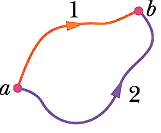
If only a conservative force acts on the particle, then the work done on the particle is the same along the two paths.
![]()
Checkpoint-1: Conservative force
The figure shows three paths connecting points a and b. A single force ![]() does the indicated work on a particle moving along each path in the indicated direction. On the basis of this information, is force
does the indicated work on a particle moving along each path in the indicated direction. On the basis of this information, is force ![]() conservative?
conservative?
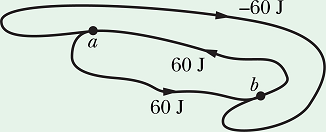
Example 1: Path Independence
A 60 kg skier starts from rest at height H=20 m above the end of a ski-jump ramp and leaves the ramp. Neglect the effects of air resistance and assume the ramp is frictionless.
How much work is done by the gravitational force from start to the end of ramp?
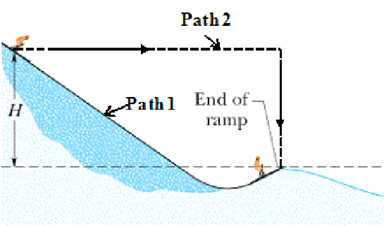
Key Idea: Work done by gravitational force (conservative force) is path independent.
Therefore work done in moving from start to end point through path-1 should be equal to work done from start to end point through path-2
Non conservative force
Consider a block attached to a spring on a surface with friction.
Push the block (click play) towards left with initial velocity ![]() and watch its kinetic energy in energy meter (red bar).
and watch its kinetic energy in energy meter (red bar).
How the kinetic energy changes with each round trip?
Single particle and Energy Principle
Consider a bouncing ball (single particle system) with Earth as the only surrounding.
Now throw the ball (click play).
The bouncing ball (system) moves under the influence of surrounding or external force (gravitational force) ![]() .
.
As per energy principle "change in kinetic energy ΔK of a single particle system (ball) is equal to work ![]() done by net surrounding or external force".
done by net surrounding or external force".
![]()
Will this method work if we treat it as a multi-particle (ball + earth) system?
Multi-particle system
A multi-particle system comprises of at least two or more particles.
Now let us imagine that bouncing ball + earth is the system (enclosed in dashed blue line).
It is a simple two particle system.
No surrounding or external force is acting on the system ![]() , therefore
, therefore
![]()
Now throw the ball.
The ball moves under the influence of gravitational force, which is now the internal force of the system ![]() .
.
Certainly kinetic energy of the ball still changes (ΔK≠0) under the influence of gravitational force.
However, there is a problem: The surrounding did no work on the system ![]() but ΔK≠0!
but ΔK≠0!
Potential Energy
Has Energy Principle been violated?
Answer to the question is a certain NO.
It only means that we have overlooked a kind of energy that is present in multi-particle systems.
This energy is associated with each pair of interacting particles inside the system.
This interacting energy of each pair is called "potential energy". Symbol U is used for potential energy.
Energy principle for a multi-particle system
Energy principle is same for a multi-particle system as it is for a single particle system.
Change in total energy of a system ![]() is equal to the work done by surrounding
is equal to the work done by surrounding ![]() (or external forces).
(or external forces).
![]()
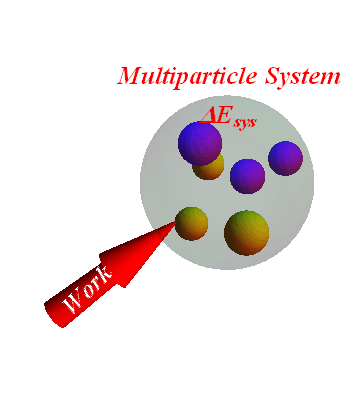
Total energy ![]() of a multi-particle (two or more particles) system is the sum of three parts.
of a multi-particle (two or more particles) system is the sum of three parts.
Sum of rest energies of each particle.
Sum of kinetic energies of each particle.
Sum of potential energies of each pair of particles.
![]()
Sum of kinetic energy and potential energy of a system is also called it mechanical energy ![]() .
.
![]()
![]()
Change in total energy ![]() of a multi-particle system contains three parts.
of a multi-particle system contains three parts.
![]()
Here Δu is the change in rest energy of the system (It will be zero as long as mass of each particle is not changing).
If mass of the system is constant or Δu=0.
![]()
Relation between ΔK and ΔU of an isolated multi-particle system
For an isolated multi-particle system, no work is done by surrounding ![]() , therefore
, therefore ![]() is zero.
is zero.
![]()
For such a system
![]()
Note: This is only true if rest energy or mass of the system is constant.
How to compute change in potential energy ΔU?
In multi-particle system, the change in potential energy of each pair (ΔU) is equal to the negative of the work ![]() done by internal force acting between the pair.
done by internal force acting between the pair.
![]()
In bouncing ball-earth system, ![]() is the work done by gravitational force (internal force) acting between the ball and earth.
is the work done by gravitational force (internal force) acting between the ball and earth.
When the ball is raised to height h, the work ![]() done by -mg force will be
done by -mg force will be
![]()
![]()
If ![]() is the initial potential energy on the ground surface and U is potential energy at height h, then
is the initial potential energy on the ground surface and U is potential energy at height h, then
![]()
If we assume that initial potential energy of an object on the ground surface ![]() , then its potential energy at height h is
, then its potential energy at height h is
![]()
Example 2: Ball and Earth
A ball of mass 100 g is 2 m above the ground, headed upward at a speed of 15 m/s. The ball comes to a momentary stop at height of 5.27 m above the ground. Consider the ball + Earth as the system. (a) What is the change in potential energy of the system? (b) What is the change in kinetic energy of the system?
Solution:
Properties of Potential Energy
Potential energy depends on the separation between pairs of interacting particles, not on their individual positions.
Potential energy must approach zero as the separation between pairs of interacting particles becomes very large.
![]()
If an interaction is attractive (gravitation force), potential energy becomes negative as the distance between particles decreases.
If an interaction is repulsive (force between like charges), potential energy becomes positive as the distance between particles decreases.
Shape of any object or system depends on separation of different interacting particles of the object. When separation between interacting pairs change, shape of the object change.
Therefore we can say that when shape of a system changes, its potential energy changes. /p>
NNo potential energy exists between non interacting/span> pairs of particles.
Potential Energy in a Block - Spring System
CConsider a block-spring system. (Click, hold and drag the block to push or pull it from equilibrium position)
For such a system, spring force span>![]() is an internal force.
is an internal force.
Work ![]() done by this internal force in moving the object from
done by this internal force in moving the object from ![]() to
to ![]() is
is

Change in potential energy of a two particle system is


The potential energy U(x) of a spring-block system at a separation x from equilibrium position x=0 will be

Potential Energy Curve
If we have a potential energy U(x) versus position x curve, we can gather a wealth of information about the motion of a particle.
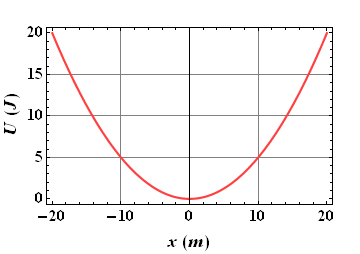
The first parameter that we can determine is the force ![]() using the potential energy versus position curve.
using the potential energy versus position curve.
Relation between force and potential energy
For one - dimensional motion, the work ![]() done by an internal conservative force
done by an internal conservative force ![]() of a system is
of a system is
![]()
Here Δx is the change in separation of two objects.
Now we can relate ![]() to its change in potential energy ΔU
to its change in potential energy ΔU
![]()
The average force ![]() during this displacement can be given as
during this displacement can be given as

If we take the limit Δx→0, the force ![]() at position x can be given as
at position x can be given as


Force at any position is the negative of the slope of potential energy U(x) vs. position x curve.
Consider a U(x)) vs. x/em> curve
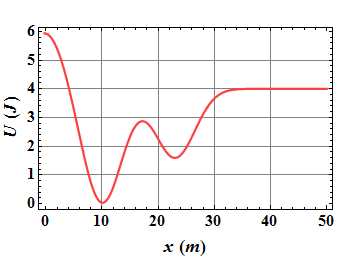
What is the slope of the curve at x=10m , x=17m, x=23m and x=40m ?
The slope of UU(x) vs. x/em> curve at x=10m , x=17m, x=23m and x=40m is zero, thus ![]() at these positions.
at these positions.
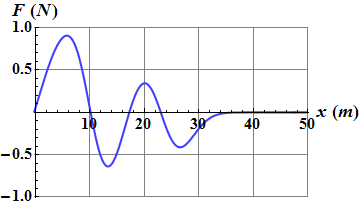
Is the slope dU/dx between x/em>=0 and x=10m and between x=10m and x=17m is positive or negative?
How to predict motion of an object from its U(x) vs. x curve?
You can imagine as if the potential energy U(x) vs. x curve corresponds to a container of same shape.
Release (click play) disk (green) and watch the motion of the disc and its shadow (red disk) on x-axis.
Shape of a roller coaster too is same as shape of its potential energy vs. position curve.
Equilibrium Points
TThe positions where the slope dU/dx=/span>0 and thus ![]() are called equilibrium points.
are called equilibrium points.
Neutral Equilibrium :
A region for which ![]() such as the region x > 35m is called a region of neutral equilibrium.
such as the region x > 35m is called a region of neutral equilibrium.
If a particle has total mechanical energy ![]() , then its kinetic energy K=0 and the particle will be stationary at any point in this region.
, then its kinetic energy K=0 and the particle will be stationary at any point in this region.
Stable Equilibrium :
Minima in UU(x) vs. x/em> are position of stable equilibrium: Like a particle with ![]() at position x=10m.
at position x=10m.
If we displace the particle either to left or right of x=10m the force will bring it back to x=10m.
Unstable Equilibrium :
Maxima in UU(x) vs. x are position of unstable equilibrium: Like a particle with ![]() at position x=17m.
at position x=17m.
If we displace the particle either to left or right of x=17m the force will tend to take it further away from x=17m.
Work done by a non-conservative force
Consider a constant horizontal external force ![]() pulling a block along x axis through a displacement
pulling a block along x axis through a displacement ![]()
Block's velocity increases from ![]() to
to ![]()
During the motion, a constant kinetic frictional force ![]() from the floor acts on the block.
from the floor acts on the block.
Therefore net force ![]() acting on the block is given as
acting on the block is given as
![]()
Total work W done by net force ![]() is equal to change in mechanical energy
is equal to change in mechanical energy ![]()
In this situation there is no change in potential energy, therefore ![]()
![]()
Or
![]()
The work ![]() done by applied force will be
done by applied force will be
![]()
Work done by force of friction ![]() changes thermal energy
changes thermal energy ![]() of the system (Block and floor gets warmer)
of the system (Block and floor gets warmer)
![]()
Therefore
![]()
In a more general situation (say, block is moving up a ramp), there can be a change in potential energy. To include such a possible change, we write
![]()
